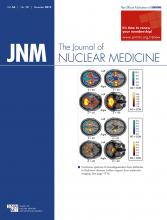Future of radiopeptides: Chatalic and colleagues provide an overview of current strategies to improve the application of radiolabels and peptides targeted at a growing range of receptors for imaging and therapy.
Page 1809
Enhancing SPECT cardiac accuracy: Gewirtz offers perspective on efforts to improve diagnostic accuracy in SPECT myocardial imaging, including the alternative promise of PET myocardial perfusion, and previews a related article in this issue of JNM.
Page 1813
Photoacoustic tomography: Mason looks at the potential and challenges of this commercially available multimodality technique using optical excitation and ultrasound detection and reviews an article on this topic in this issue of JNM.
Page 1815
Respiration-gated PET and -triggered CT: van der Vos and colleagues investigate the effect of respiration-triggered CT on the spatial match between CT and amplitude-based respiration-gated PET images and describe the implications of their results for radiation therapy planning.
Page 1817
68Ga-NOTA-PRGD2 PET/CT in lung cancer: Zheng and colleagues assess the diagnostic value of this dimeric arginine-glycine-aspartic acid peptide, designed for integrin imaging, in patients with suggestive lung lesions and compare results with those from 18F-FDG PET/CT.
Page 1823
GSK2141795 in ovarian cancer: Gungor and colleagues examine the relationship between this serine/threonine–specific protein kinase inhibitor and 18F-FDG PET glucose metabolism markers in tumor tissue to determine the utility of 18F-FDG PET in guiding personalized dosing in gynecologic malignancies.
Page 1828
11C-choline PET/CT in prostate cancer: Incerti and colleagues explore the predictive capabilities of 11C-choline PET/CT on a range of survival outcomes in patients treated with helical tomotherapy after biochemical failure following primary treatment for prostate cancer.
Page 1836
68Ga-DOTANOC PET/CT in pancreatic NETs: Ambrosini and colleagues detail the role of 68Ga-DOTANOC SUVmax as a potential prognostic factor in patients with pancreatic neuroendocrine tumors.
Page 1843
Pheochromocytoma/paraganglioma and 18F-FLT PET/CT: Blanchet and colleagues evaluate this PET proliferation tracer in a series of patients with neuroendocrine tumors and different genetic backgrounds, compare tracer uptake with that of 18F-FDG, and evaluate disease aggressiveness factors.
Page 1849
Test–retest 18F-fluciclatide PET in solid tumors: Sharma and colleagues report on the multicenter reproducibility of PET imaging in multiple solid tumor types with this radiolabeled peptide with high affinity for αvβ3/αvβ5 integrin.
Page 1855
Comparative modalities in breast and prostate cancer: Minamimoto and colleagues evaluate the use of combined 18F-NaF/18F-FDG PET/CT in patients with breast and prostate cancer and compare results with those from 99mTc-MDP bone scintigraphy and whole-body MRI.
Page 1862
IPF, 18F-FDG PET, and prognosis: Umeda and collagues determine whether dual-time-point 18F-FDG PET imaging results are useful in predicting early pulmonary function deterioration and long-term survival in patients with idiopathic pulmonary fibrosis.
Page 1869
Dual-gated motion-frozen cardiac PET: Slomka and colleagues assess the feasibility and benefit of simultaneous correction of respiratory and cardiac motion in PET perfusion imaging with 18F-flurpiridaz.
Page 1876
Systolic myocardial perfusion SPECT: Kitkungvan and colleagues look at the incremental benefit of evaluation of relative activity distribution in systolic images on sensitivity and specificity in electrocardiograph-gated SPECT myocardial perfusion imaging.
Page 1882
Assessing postsystolic shortening in CAD: Kanzaki and colleagues investigate the utility of resting postsystolic shortening as assessed by quantitative gated SPECT in identifying patients with coronary artery disease.
Page 1889
64Cu-DOTATATE and atherosclerosis: Malmberg and colleagues compare the uptake of 68Ga-DOTATOC and 64Cu-DOTATATE in large arteries on PET/CT imaging as a measure of atherosclerosis and correlate uptake and cardiovascular risk factors.
Page 1895
Human kinetic modeling of 11C-GSK215083: Parker and colleagues describe the quantification and pharmacologic selectivity of this 5HT6 PET ligand in healthy volunteers and its use to measure occupancies achieved at various doses of a novel 5HT6.
Page 1901
Binding-potential 11C-PiB PET: Hosokawa and colleagues ask whether binding-potential images using 11C-Pittsburgh compound B and dynamic PET can reliably detect cortical amyloid deposits in patients with ambiguous 11C-PiB static images and whether visual ratings are affected by white matter retention.
Page 1910
Metabolic topology of neurodegeneration: Granert and colleagues detail the development of a topological map based on regional patterns of cerebral glucose metabolic rate measured with 18F-FDG PET in patients with a range of neurodegenerative impairments.
Page 1916
Imaging applications in cancer therapy: Troost and colleagues provide an educational overview of current functional, metabolic, anatomic, and hybrid approaches for tumor localization, characterization, and monitoring of effectiveness in evolving cancer treatment methods.
Page 1922
Abcg2/ABCB1 transport of 11C-erlotinib: Traxl and colleagues use 11C-erlotinib PET to explore the effect of these efflux transporter breast cancer resistance proteins and P-glycoproteins on the tissue distribution of erlotinib in a mouse model.
Page 1930
CB1 as a BAT imaging biomarker: Eriksson and colleagues describe a technique for quantifying cannabinoid receptor 1 in brown adipose tissue with the radiolabeled antagonist 18F-FMPEP-d2 in a rat model.
Page 1937
Photoacoustic imaging of tumor vasculature: Bohndiek and colleagues assess the potential of in vivo photoacoustic tomography for direct functional measurement of ovarian tumor response to antiangiogenic therapy with trebananib in mice.
Page 1942
SiPM- and PMT-based preclinical PET: Krizsan and colleagues compare a small-animal PET system using state-of-the-art silicon photomultiplier photosensors for dual-modality imaging with MRI and a system with the same crystal geometry but conventional photomultiplier tubes.
Page 1948
18F-FPEB PET for mGluR5: de Laat and colleagues report on the pharmacokinetics of this radioligand that is selective for metabotropic glutamate receptor 5 and use it to quantify mGluR5 in the rat brain.
Page 1954
Reference levels in nuclear medicine: Alessio and members of the SNMMI Dose Optimization Task Force provide an overview of the roles of diagnostic reference levels and achievable doses in nuclear medicine practice, guidelines, and education.
Page 1960
- © 2015 by the Society of Nuclear Medicine and Molecular Imaging, Inc.







